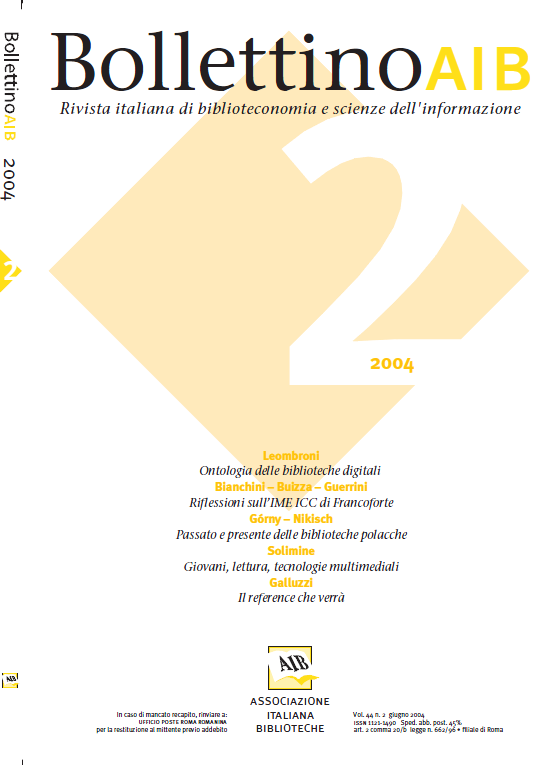Young people, reading, multimedia techniques
Main Article Content
Abstract
The study analyses adolescents' and young peoples' tastes and behaviour in reading, in the light also of the environmental conditionings that determine them: the aim is also that of examining the relations that exist between traditional cultural consumption - first of all reading and library use - the use of informatic tools and multimedia technology, especially for checking if there is any truth to the bet (or perhaps it would be more correct to speak of "illusion") of those who consider that young people can be brought closer to reading through the new communication languages.
The investigation was carried out in 2002-2003 among 7396 students of lower and higher secondary schools, who were interviewed in basic public libraries or inside schools in which there was a functioning school library. The sample group was composed of 48.6% male and 51.4% female students. The distribution by age groups is as follows: 1.5% are under 11 years of age, 25.2% are between 11 and 13 years of age, 25.6% are between 14 and 15 years of age, 28.5% are between 16 and17 years old, 17.7% are between 18 and 19 years old, while 1.5% are over 20.
The work indication for teachers, librarians and those who work within the processes of knowledge transmission is that integration between written culture and the digital world must be promoted, and that the most effective path to follow for achieving this goal among young people for now is probably still that of education to reading and study through a familiarity with the traditional "object book": whoever masters a book and the mechanisms of reading can then become a conscious user of the network and best use its potential as an instrument of entertainment and satisfaction of intellectual curiosity , both as a support for study and for research.
The investigation was carried out in 2002-2003 among 7396 students of lower and higher secondary schools, who were interviewed in basic public libraries or inside schools in which there was a functioning school library. The sample group was composed of 48.6% male and 51.4% female students. The distribution by age groups is as follows: 1.5% are under 11 years of age, 25.2% are between 11 and 13 years of age, 25.6% are between 14 and 15 years of age, 28.5% are between 16 and17 years old, 17.7% are between 18 and 19 years old, while 1.5% are over 20.
The work indication for teachers, librarians and those who work within the processes of knowledge transmission is that integration between written culture and the digital world must be promoted, and that the most effective path to follow for achieving this goal among young people for now is probably still that of education to reading and study through a familiarity with the traditional "object book": whoever masters a book and the mechanisms of reading can then become a conscious user of the network and best use its potential as an instrument of entertainment and satisfaction of intellectual curiosity , both as a support for study and for research.
Article Details
Section
Articles

This work is licensed under a Creative Commons Attribution-ShareAlike 4.0 International License.
